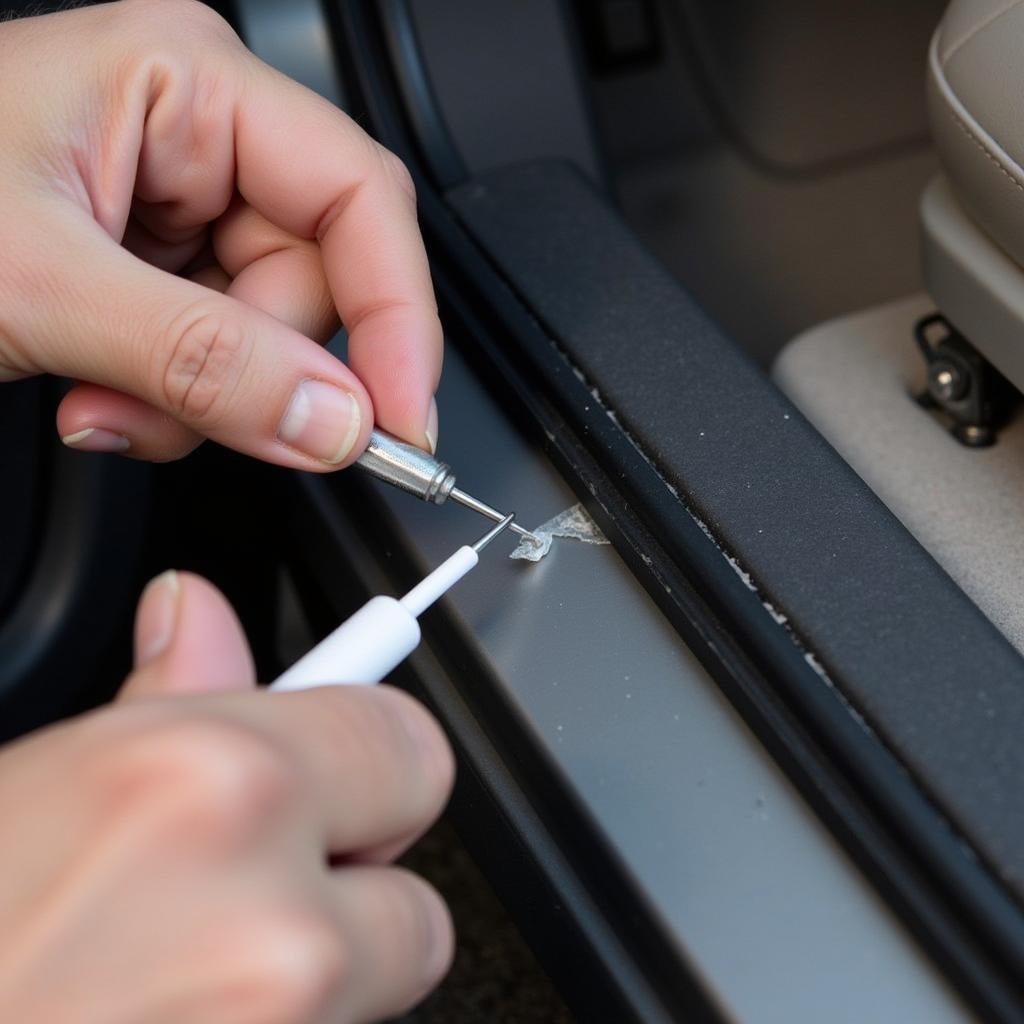A cut car tire can be a real headache, leaving you stranded and frustrated. Whether it’s a small puncture or a large gash, knowing how to address this issue is crucial for every car owner. This guide will walk you through various scenarios of tire damage, from identifying the problem to implementing the best solution. We’ll cover temporary fixes like using a tire sealant and more permanent solutions like patching or replacing the tire.
Identifying the Culprit: Types of Tire Cuts
Before you can fix a cut car tire, you need to understand the nature of the damage. Is it a small puncture from a nail? A larger gash from a sharp object? Or sidewall damage from scraping against a curb? Each type of cut requires a slightly different approach. Small punctures are often repairable with a plug or patch, while larger cuts and sidewall damage usually necessitate tire replacement. Accurately assessing the damage is the first step towards getting back on the road safely.
Temporary Fixes for a Cut Tire: Get You Rolling Again
Sometimes, a full repair isn’t immediately possible. In these situations, temporary fixes can be lifesavers, allowing you to reach a repair shop or safely get home. Tire sealant is a popular option. This canned solution is injected into the tire through the valve stem, filling the cut and temporarily sealing the leak. Remember, tire sealant is just a temporary solution. It’s essential to have the tire properly inspected and repaired or replaced as soon as possible. Another temporary fix is using a tire plug kit, which involves inserting a rubber plug into the puncture. While effective for small punctures, plugs are not recommended for larger cuts or sidewall damage.
If you’re dealing with burns in your car seats, you can find helpful information on how to fix cigarette burn on car seat.
Long-Term Solutions: Patching vs. Replacing
For a permanent solution to a cut car tire, you have two main options: patching or replacing. Patching involves applying a patch to the inside of the tire, covering the damaged area. It’s a cost-effective solution for small punctures, but not all cuts are patchable. Larger cuts, cuts near the sidewall, or cuts that have caused significant internal damage will require tire replacement. While more expensive, replacing the tire ensures your safety and prevents further issues down the road.
When to Replace a Cut Tire: Safety First
Sidewall damage, large cuts, or cuts that have exposed the tire’s internal structure are clear indicators that the tire needs to be replaced. Driving on a compromised tire is dangerous and can lead to blowouts, loss of control, and accidents. Don’t compromise your safety. If you’re unsure whether a tire can be patched or needs to be replaced, consult a tire professional. They have the expertise to assess the damage and recommend the best course of action.
You can learn more about fixing cigarette burns in your car seats at fixing cigarrette burns in car seats.
Preventing Tire Cuts: Proactive Measures
While not all tire cuts are preventable, taking some proactive measures can significantly reduce your risk. Regularly check your tire pressure and inspect your tires for any signs of wear and tear, including cuts, bulges, or embedded objects. Avoid driving over potholes, debris, and curbs whenever possible. By being proactive and vigilant, you can extend the life of your tires and minimize the chances of encountering a frustrating flat tire due to a cut.
“Regular tire inspections are crucial for catching potential problems early on, including cuts. A small cut, if addressed promptly, can often be repaired, saving you the cost of a new tire.” – John Smith, Certified Automotive Technician
Conclusion: Don’t Let a Cut Tire Ruin Your Day
Knowing how to fix a cut car tire is an essential skill for any driver. From temporary fixes to get you back on the road to permanent solutions like patching or replacing, understanding the options available empowers you to make informed decisions. Remember, prioritizing safety is paramount. Don’t hesitate to seek professional advice if you’re unsure about the extent of the damage or the best course of action.
Need expert assistance? Contact AutoTipPro at +1 (641) 206-8880 or visit our office at 500 N St Mary’s St, San Antonio, TX 78205, United States. We’re here to help!
Looking for information on the cost of car seat repairs? Check out this resource: how much to fix cigarette burn in car seat. Also, if you’re specifically dealing with leather seats, this guide might be helpful: fixing cigarette burn on leather car seat. For another perspective on addressing cigarette burns, see this article: how to fix a cigarette burn in a car seat.





Leave a Reply